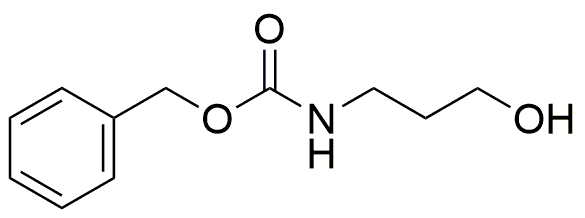3-(Benzyloxycarbonylamino)-1-propanol is widely utilized in research focused on:
- Pharmaceutical Development: This compound serves as a key intermediate in the synthesis of various pharmaceuticals, particularly in the development of drugs targeting neurological disorders.
- Bioconjugation: It is used in bioconjugation processes, allowing researchers to attach biomolecules to surfaces or other compounds, enhancing drug delivery systems.
- Peptide Synthesis: The compound plays a significant role in peptide synthesis, providing a protective group that facilitates the formation of complex peptide structures.
- Research in Organic Chemistry: It is a valuable reagent in organic chemistry for creating derivatives and studying reaction mechanisms, aiding in the understanding of chemical behavior.
- Cosmetic Formulations: The compound is explored in cosmetic formulations for its potential benefits in skin care products, offering moisturizing properties and improving product stability.
Información general
Propiedades
Seguridad y normativas
Aplicaciones
3-(Benzyloxycarbonylamino)-1-propanol is widely utilized in research focused on:
- Pharmaceutical Development: This compound serves as a key intermediate in the synthesis of various pharmaceuticals, particularly in the development of drugs targeting neurological disorders.
- Bioconjugation: It is used in bioconjugation processes, allowing researchers to attach biomolecules to surfaces or other compounds, enhancing drug delivery systems.
- Peptide Synthesis: The compound plays a significant role in peptide synthesis, providing a protective group that facilitates the formation of complex peptide structures.
- Research in Organic Chemistry: It is a valuable reagent in organic chemistry for creating derivatives and studying reaction mechanisms, aiding in the understanding of chemical behavior.
- Cosmetic Formulations: The compound is explored in cosmetic formulations for its potential benefits in skin care products, offering moisturizing properties and improving product stability.
Documentos
Hojas de datos de seguridad (HDS)
La SDS proporciona información de seguridad completa sobre la manipulación, el almacenamiento y la eliminación del producto.
Especificación del producto (PS)
La PS proporciona un desglose completo de las propiedades del producto, incluida la composición química, el estado físico, la pureza y los requisitos de almacenamiento. También detalla los rangos de calidad aceptables y las aplicaciones previstas del producto.
Certificados de análisis (COA)
Busque certificados de análisis (COA) ingresando el número de lote del producto. Los números de lote y de partida se pueden encontrar en la etiqueta de un producto después de las palabras "Lote" o "Lote".
Número de catálogo
Número de lote/lote
Certificados de origen (COO)
Este certificado de origen confirma el país en el que se fabricó el producto y también detalla los materiales y componentes utilizados en él y si se deriva de fuentes naturales, sintéticas u otras fuentes específicas. Este certificado puede ser necesario para cumplir con las normativas aduaneras, comerciales y regulatorias.
Número de catálogo
Número de lote/lote
Hojas de datos de seguridad (HDS)
La SDS proporciona información de seguridad completa sobre la manipulación, el almacenamiento y la eliminación del producto.
DownloadEspecificación del producto (PS)
La PS proporciona un desglose completo de las propiedades del producto, incluida la composición química, el estado físico, la pureza y los requisitos de almacenamiento. También detalla los rangos de calidad aceptables y las aplicaciones previstas del producto.
DownloadCertificados de análisis (COA)
Busque certificados de análisis (COA) ingresando el número de lote del producto. Los números de lote y de partida se pueden encontrar en la etiqueta de un producto después de las palabras "Lote" o "Lote".
Número de catálogo
Número de lote/lote
Certificados de origen (COO)
Este certificado de origen confirma el país en el que se fabricó el producto y también detalla los materiales y componentes utilizados en él y si se deriva de fuentes naturales, sintéticas u otras fuentes específicas. Este certificado puede ser necesario para cumplir con las normativas aduaneras, comerciales y regulatorias.

